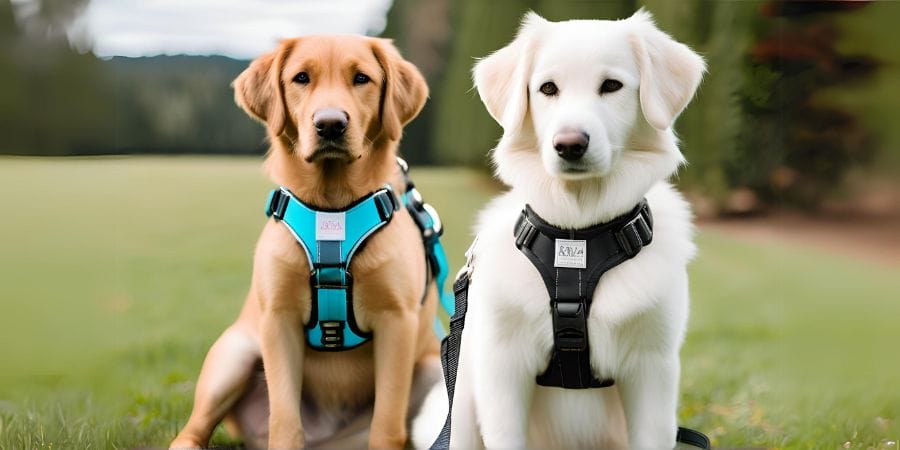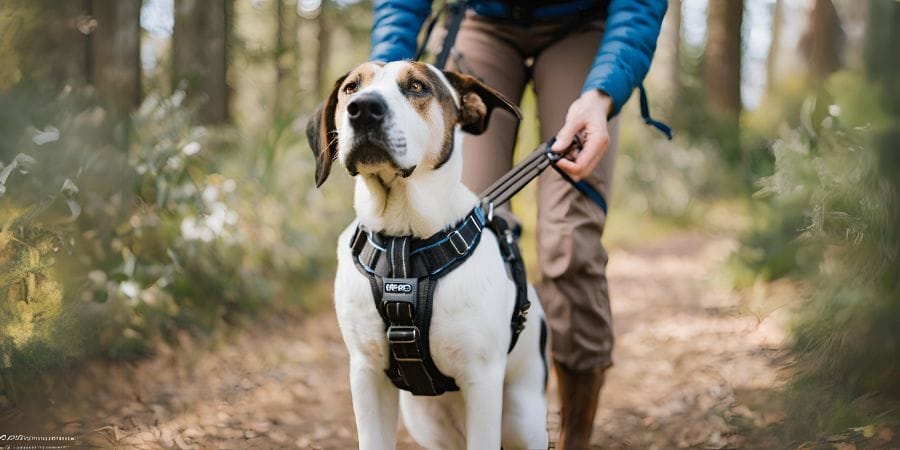Training a puppy is a joyous yet challenging endeavor that lays the foundation for a well-behaved and happy canine companion. From mastering basic obedience commands to ensuring proper socialization and leash manners, each aspect of training contributes to a well-rounded pet. Among the various tools available to aid in this process, the no-pull harness stands out as an essential asset for both new and experienced pet owners. Unlike traditional collars, a no-pull harness offers enhanced safety, better control, and increased training efficiency, making walks more enjoyable and less stressful. In this article, we’ll delve into the importance of using a no-pull harness for puppy training, explore its benefits, compare it with traditional collars, and provide practical tips for selecting and using the right harness to ensure a successful training journey.
Training a puppy is a rewarding yet challenging journey that lays the foundation for a well-behaved and happy dog. Training basics encompass three critical areas: obedience, socialization, and leash training. Obedience training focuses on teaching your puppy fundamental commands such as “sit,” “stay,” “come,” and “down.” These commands not only instil discipline but also ensure the safety of your puppy in various situations.
Socialization involves exposing your puppy to environments, people, and other animals to help them become well-adjusted and confident. This process is crucial during the early stages of a puppy’s life, as it can prevent behavioural issues such as fear and aggression later on.
Leash training is another essential aspect of puppy training. It teaches your puppy to walk calmly on a leash, making outings more enjoyable for both of you. However, one common challenge faced during leash training is pulling. Full of energy and curiosity, puppies often pull on the leash, making walks difficult and sometimes hazardous.
Pulling on the leash is one of the most frequent issues during puppy training. This behaviour makes walks stressful and can lead to potential injuries for both the puppy and the owner. Puppies pull on the leash for various reasons, including excitement, curiosity, and sometimes fear. Addressing this behaviour early on is crucial for establishing good walking habits.
Another challenge is maintaining your puppy’s attention during training sessions. Puppies have short attention spans and can easily get distracted by their surroundings. Consistency and patience are vital in overcoming this hurdle.
House training is also a significant part of the early training phase, where accidents are bound to happen. Understanding these common challenges and preparing to tackle them with practical strategies can make the training process smoother and more successful.
A no-pull harness is a specialized dog harness designed to discourage pulling behaviours during walks. Unlike traditional collars and harnesses that attach the leash to the back or around the neck, a no-pull harness typically features a front clip attachment point on the chest. This design helps to redirect the dog’s forward momentum, reducing their ability to pull effectively.
No-pull harnesses have several key features that set them apart from traditional options. One of the most notable features is the front clip attachment. This attachment point is strategically placed on the dog’s chest, making it difficult to pull forward without being gently turned back towards the owner. This redirection helps to curb pulling behaviour naturally.
Adjustable straps are another essential feature of no-pull harnesses. These straps ensure a snug and comfortable fit for dogs of all sizes, preventing discomfort or chafing during use. The adjustability also allows for a customized fit, accommodating the growth of puppies as they mature.
Comfortable materials are essential in the construction of no-pull harnesses. Typically, these harnesses are made from soft, breathable fabrics that prevent skin irritation and provide maximum comfort during walks. Some designs also include padded areas to enhance comfort further, especially around the chest and shoulders.

One of the primary benefits of using a no-pull harness is the enhanced safety it provides for your puppy. Traditional collars can exert pressure on a puppy’s neck and throat, potentially leading to injuries such as tracheal damage or neck strain. In contrast, a no-pull harness distributes the pressure evenly across the dog’s chest and shoulders, significantly reducing the risk of injury.
A no-pull harness offers better control during walks, making the experience more pleasant for the owner and the puppy. The front clip design allows the owner to steer the puppy gently, minimizing pulling and making it easier to manage their movements. This increased control is especially beneficial for energetic puppies still learning proper leash manners.
Using a no-pull harness can significantly enhance the effectiveness of your training sessions. By discouraging pulling behaviour, the harness helps to reinforce positive walking habits. Puppies quickly learn that pulling does not result in forward movement, encouraging them to walk calmly beside their owner. This improved behaviour makes walks more enjoyable and accelerates the overall training process.
Traditional collars, while common, can pose several health risks to dogs, particularly when they pull on the leash. Collars can place undue pressure on the dog’s neck and throat, leading to potential injuries such as tracheal damage, neck strain, and even spinal issues. This pressure can also cause discomfort and pain, making walks an unpleasant experience for your puppy.
In contrast, no-pull harnesses are designed to distribute pressure evenly across the dog’s chest and shoulders, significantly reducing the risk of injury. This design minimizes the strain on sensitive areas like the neck and throat, promoting better overall health and comfort for your puppy.
Traditional collars can exacerbate pulling behaviour and other undesirable habits. When a puppy pulls on a collar, the natural response is to pull back, creating a cycle of resistance and increased tearing. This can make walks stressful and challenging for the puppy and the owner.
No-pull harnesses, however, are engineered to address this issue effectively. Attaching the leash to the front of the harness, the puppy is gently redirected towards the owner whenever they attempt to pull. This redirection discourages pulling behaviour and encourages the puppy to walk calmly by the owner’s side. Over time, this can lead to significant behavioural improvements, making walks more enjoyable and manageable.

Choosing the proper no-pull harness for your puppy involves considering several important factors:
1. Size: Ensure the harness fits your puppy correctly. It should be snug but not too tight, allowing for comfortable movement.
2. Material: Look for harnesses made from durable, breathable materials that won’t irritate your puppy’s skin. Padded areas can enhance comfort.
3. Adjustability: An adjustable harness allows you to customize the fit as your puppy grows. Look for multiple adjustment points for a secure and comfortable fit.
4. Durability: Select a harness built to withstand daily use and the wear and tear of outdoor activities. Strong stitching and robust buckles are essential.
There are several types of no-pull harnesses available, each with unique features:
1. Front Clip Harnesses: These harnesses have a leash attachment point on the chest, which is ideal for discouraging pulling by redirecting the dog’s movement.
2. Dual Clip Harnesses: These offer front and back attachment points, providing versatility for different training scenarios and walking preferences.
3. Back Clip Harnesses: While not explicitly designed as no-pull harnesses, some back clip models offer features that help reduce pulling, such as ergonomic designs and comfortable fits.
Selecting the best harness for your puppy depends on their specific needs and your training goals.
1. Measure Your Puppy: Use a soft measuring tape to measure your puppy’s chest girth, just behind the front legs. Refer to the harness size chart to find the appropriate size.
2. Loosen All Straps: Before putting the harness on your puppy, loosen all the straps to make fit easier.
3. Place the Harness on Your Puppy: Slip the harness over your puppy’s head, ensuring the chest strap is positioned correctly.
4. Adjust the Straps: Adjust the straps around the chest and neck to achieve a snug but comfortable fit. You should be able to fit two fingers between the harness and your puppy’s body.
5. Check the Fit: Ensure the harness is not too tight or loose. The D-ring should rest on the puppy’s chest for a front clip harness.
6. Test for Comfort: Have your puppy walk around with the harness to ensure they are comfortable and not restricted in movement.

Introducing a no-pull harness to your puppy should be a gradual process:
1. Familiarization: Let your puppy sniff and investigate the harness to become comfortable with it.
2. Positive Association: Use treats and praise to create a positive association with the harness.
3. Short Sessions: Start with short-wearing sessions indoors before progressing to outdoor walks.
Effective leash training techniques can enhance the benefits of a no-pull harness:
1. Start Indoors: Begin training in a low-distraction environment like your home or backyard.
2. Short Walks: Keep initial walks short and gradually increase the duration as your puppy becomes more accustomed to the harness.
3. Redirection: Use the front clip to gently redirect your puppy’s movement when they pull, reinforcing calm walking behaviour.
Positive reinforcement is critical to successful training:
1. Rewards: Use treats, toys, and praise to reward your puppy for walking calmly by your side.
2. Consistency: Be consistent with your commands and rewards to reinforce good behaviour.
3. Patience: Training takes time and patience. Celebrate small victories and be patient with setbacks.
Using these training tips and techniques, you can maximize the effectiveness of a no-pull harness and enjoy more pleasant walks with your puppy.
using a no-pull harness for puppy training is a smart and effective choice that offers numerous benefits for both you and your furry friend. This essential tool promotes safety by reducing the risk of injury to your puppy’s neck and spine, enhances control during walks, and improves training efficiency by discouraging pulling behavior. By choosing the right no-pull harness, fitting it correctly, and employing positive reinforcement techniques, you can transform your walks into enjoyable experiences and foster better behavior in your puppy. We encourage pet owners to consider incorporating a no-pull harness into their training regimen, ensuring a happier, healthier, and more harmonious relationship with their beloved pets.
As part of our mission to bring pet lovers the very best quality cat and dog accessories, we’ll be adding new and exciting products to our collection.
Stay tuned for some paw-sitively amazing new accessories coming to our website soo
Sign up for our email list to get
your first patog.com.au order.*